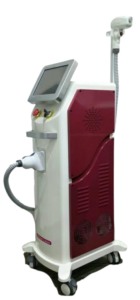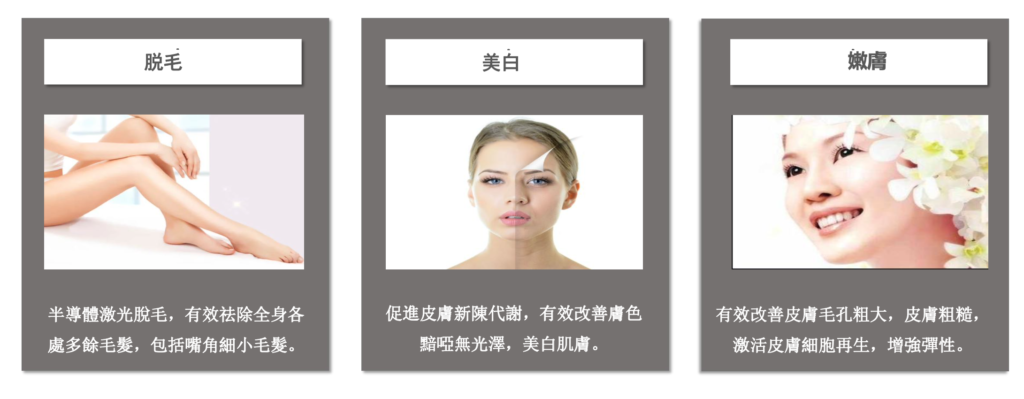
810nm Semiconductor laser hair removal device
The 810nm laser uses semiconductor hair removal technology from Hong Kong, this 810nm laser wavelength effectively penetrates the skin to reach the hair follicle, where it generates heat to disrupt the hair growth structure, causing instant shrinking of the hair follicle, strongly inhibiting hair regeneration. This new generation laser is designed for hair removal, with improved melanin absorption at this wavelength, it gained its title as the "King of Laser Hair Removal". By reducing haemoglobin's absorption of the laser, paired with a rare sapphire treatment applicator that closely adheres to the skin, it uses a dual cooling system to cool the epidermis down to 5°C, effectively protecting the skin from heat damage.
How does 810nm Semiconductor laser hair removal device works:
- 810nm Semiconductor laser hair removal is based on the principle of selective photothermal action, where melanin in hair shaft and follicles are abundant. The 810nm laser wavelengths precisely target melanin, enabling selective hair removal treatment.
- 810nm laser wavelengths penetrate the skin to reach the hair follicle with strong and quick successions, and do not damage epidermal cells and skin tissue.
- 810nm laser wavelengths light source only acts on hair follicles and does not affect sebaceous glands or sweat glands. Therefore, the body’s normal diaphoresis remains unaffected.
Advantages:
"No anesthesia is required, ensuring that the epidermis is not burned. The treatment process is painless and efficient. The size of the treatment applicator allows each procedure to remove large amount of hair in one session. Thanks to its built-in sealed circulation water cooling system, the device can be adjusted based on skin conditions during the hair removal process. This feature helps shorten treatment time while ensuring that the skin temperature does not rise excessively, preventing any risks of burns.
Safe:
The high-permeation wavelength effectively destroys hair follicles beneath the skin, delivering more noticeable hair removal results while also suppressing harmful ultraviolet rays that could impact the skin.
Efficient:
By utilizing focused and high-powered light beams, the light efficiency has been significantly enhanced. The use of gentle visible light laser technology, combined with the latest advancements, demonstrates improved stability of the laser.
810nm semiconductor laser hair removal areas of treatment:

Clinical Key Points for Operations and Precautions:
Key Points for Operation
- Prior to hair removal, patient must be thoroughly shaven.
- The applicator is held vertically and gently glided along the skin during the procedure.
- Gliding from point A to point B, then back from point B to point A, ensures effective heat-based hair removal.
Precautions
- During the treatment process, there may be slight tingling or warmth. After the treatment, the treated area may experience mild redness, swelling, and a warm sensation.
- The clinical endpoint for hair removal is characterized by redness around the hair follicles, localized heat with a tingling sensation, and a burnt hair smell.
- Skin tone variations can lead to different feelings and reactions during treatment.
- In rare cases, hair may turn white yet continue to grow, or hair density may increase instead of decrease after treatment.
- Lip hair might require multiple sessions to achieve satisfactory results.
- Coarse and dense hair may give a pulling sensation during the procedure.
- Keep the treated area dry for 8 hours and avoid contact with water.
- Refrain from saunas and hot baths for 7 days.
- Avoid fillers or other injection treatments for 2 weeks after treatment, and avoid spicy foods, irritating or pigment-inducing foods, as well as seafood and allergenic foods.
Contraindications:
1) Individuals with photosensitivity.
2) Individuals with a history of tanning or those who are about to be exposed to intense sunlight should proceed with caution during treatment.
3) Individuals who have used functional cosmetics (such as anti-spot or whitening products) within the past two months.
4) Individuals with severe heart disease, diabetes, hypertension, epilepsy, etc., as well as women with pregnancy.
5) Individuals with herpes infections or extensive skin damage.
6) Patients with pigmentation spots similar to their skin tone or those with overly high expectations.
